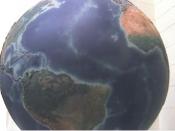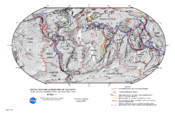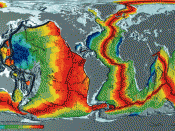Continental Drift Continental drift is the theory that the positions of the earth's continents have changed a lot through geologic time. The German meteorologist Alfred Wegener proposed the first comprehensive theory of continental drift in 1912, on the basis of the way the continents fit together on the opposing Atlantic coasts and paleontology correlation on both sides of the Atlantic. He proposed the theory that about 200 million years ago there was one great big continent, or supercontinent, called Pangaea. Pangaea split into two big landmasses, Laurasia and Gondwanaland.
The present continents separated in the next geologic era, the Mesozoic. In this process, the Earth's rotation caused horizontal alterations in the granite continents floating on the sea of the basaltic ocean floors. The frictional drag along the leading edges of the drifting continents created mountains. Wegener's theory met controversy until 1954, when British geophysicists seeking to explain the phenomenon of polar wandering revived it.
Since then, the modern theory of Plate Tectonics has evolved from and replaced Wegener's original thesis.
Plate Tectonics is the theory that deals with the structure, history, and dynamics of the earth's crust. The earth's crust is formed of 13 continental plates. The boundaries of the zones are where tectonic activities occur, and where earthquakes and volcanic eruptions tend to happen. The plate tectonics theory was thought up in the 1960s and 1970s, with ideas taken from Wegener?s earlier thoughts. Earlier, Wegener and other scientists had noted that continental crust grows by additions and that a ridge in the middle of the ocean runs almost all the way around the world. It was also noted that continental plates tear apart, drift apart, and collide with each other.
Seafloor Spreading Geophysicists, mapping the ocean floor with an instrument that measures magnetic fields, showed that the rocks on...


